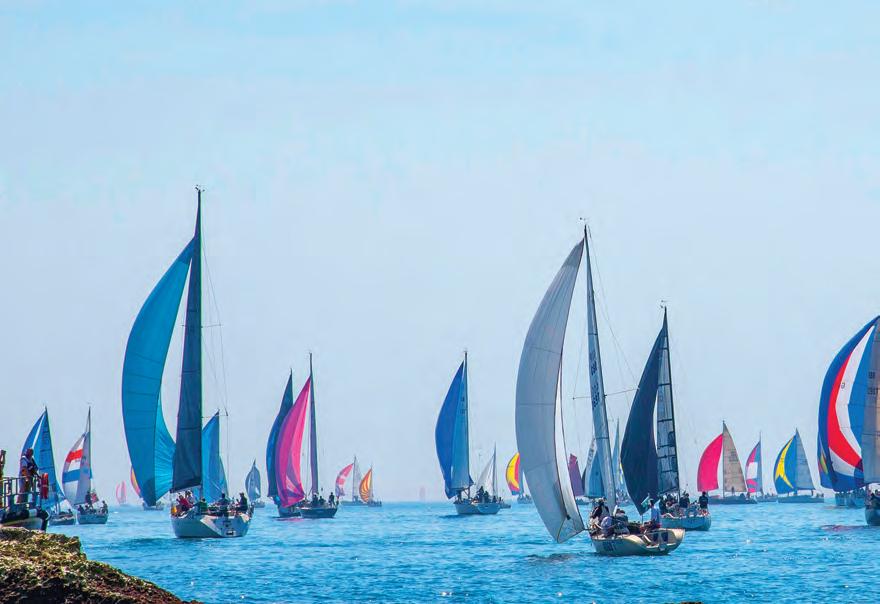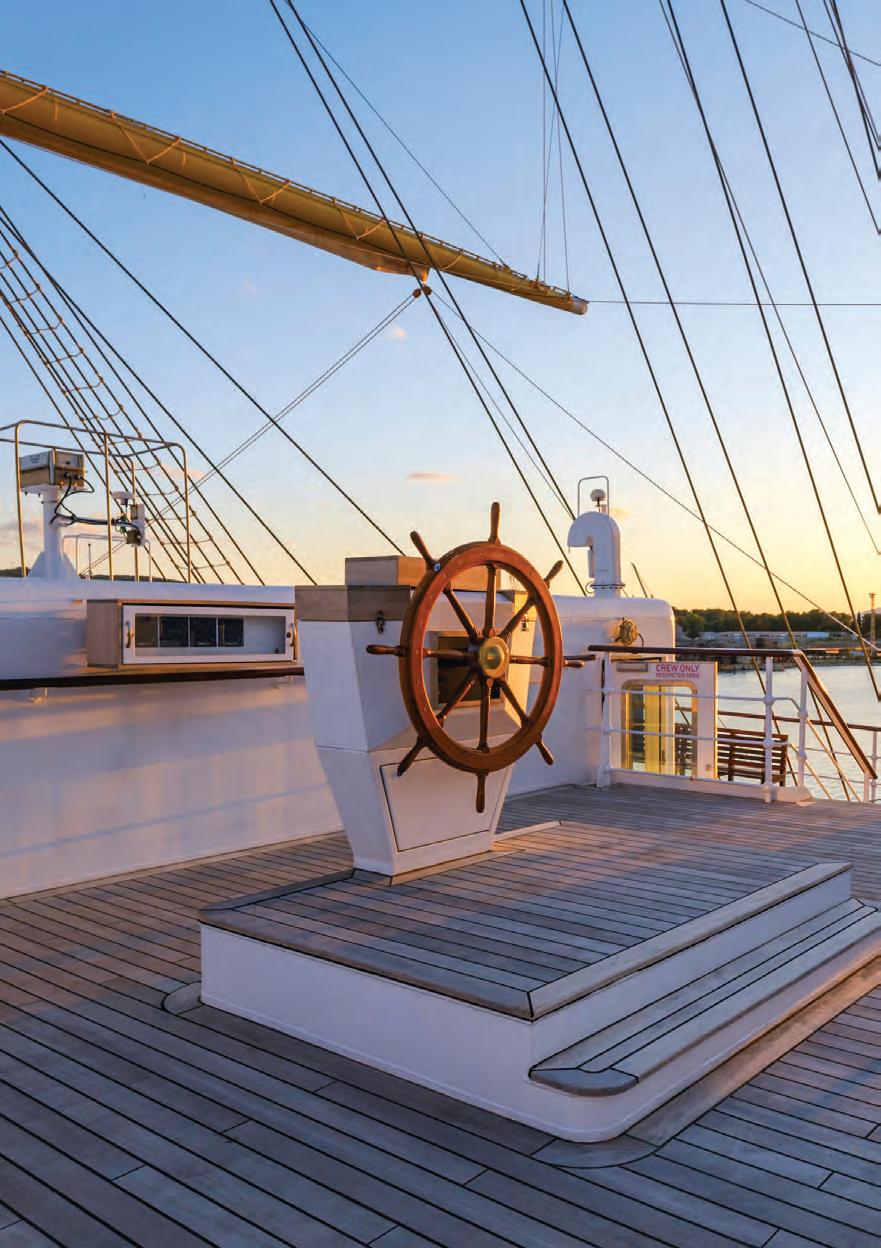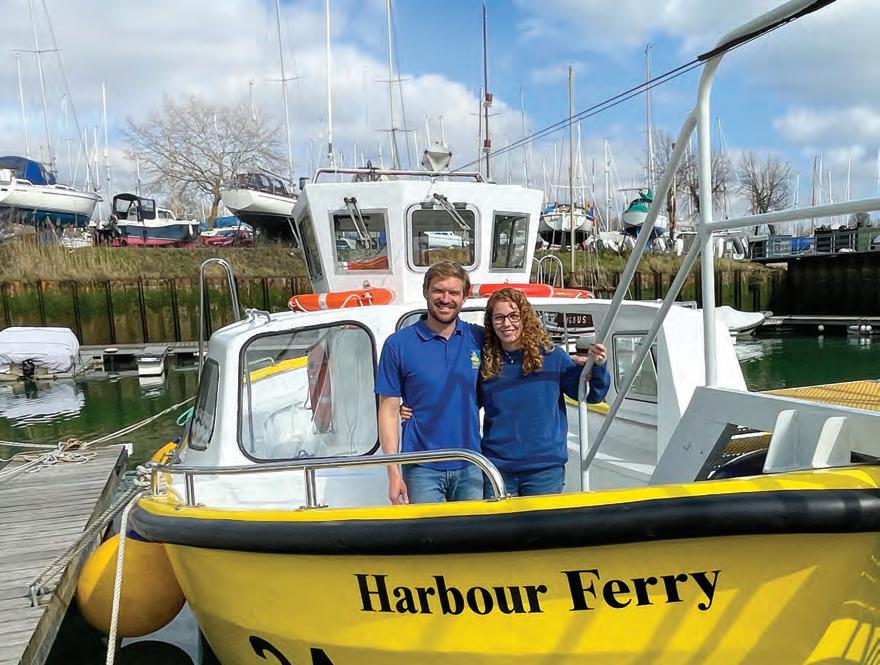
24 minute read
Shipbuilding Anglo-Saxon style
An ambitious reconstruction project connects the region’s maritime heritage with a modern-day sense of discovery
With a cast of A-listers and the beautiful Suffolk landscape as its backdrop, it’s no wonder that Netflix hit The Dig won numerous plaudits within weeks of its release.
Advertisement
The true ‘star’ of the movie, however – an Anglo-Saxon King’s burial ship – never actually appears on-screen. It couldn’t, because after laying hidden underground in the Sutton Hoo royal burial ground since the 7th century, all that remained when it was discovered in 1939 was the imprint it had left in the sand.
But now, from this imprint plus British Museum archives, archaeological records, 3D computer modelling and other techniques, experts have been able to create scale models of how the King’s ship would have looked, and to understand how it was built. And all this has enabled work to begin on a full-size 90ft replica which, once complete, will slip once more into the water.
It’s a venture that brings together archaeologists, historians, experts in construction and shipbuilding and many other skilled volunteers, and has given birth to The Sutton Hoo Ship’s Company (SHSC). And it’s fitting that the work of this registered charity is taking place at The Longshed in Woodbridge – a town with a rich boatbuilding heritage, directly across the River Deben from the original ship’s burial site.
The work is not without complications, however. When it was first excavated, for example, the ship was lying a few degrees off horizontal, which made the shape in the sand asymmetrical. And, because of the way in which it was buried, the ship was ‘broken backed’ rather than having a natural curve to the keel.
Reconstructing the ship will take about three years and involve many steps, from turning computer specifications into workable plans, to finally finishing the oars that will be used to row it down the River Deben. The team are sticking to authentic materials and methods as much as possible, so the ship is to be built mainly from green oak – for the keel a piece 50ft long and around 12 x 8inches round is required. This is followed by shaping the stem and the stern of the boat from oak, work that includes nine planks » TheCoastalGuide 2021 43

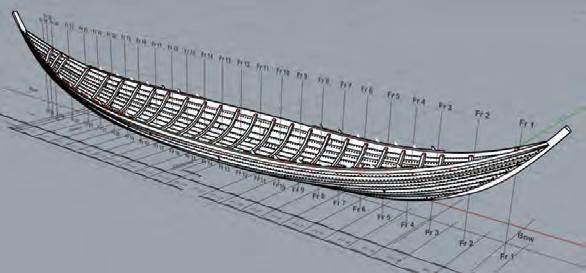
» each side, the ribs, tholes for the oars to rest against, thwarts to sit on and a rudder to steer.
“Wherever possible and practical, we’re sticking to Anglo-Saxon boatbuilding techniques,” says Trustee Simon Steel. “However, in some key areas we have made the decision to do things differently. Primarily, this is in two areas: the milling of the rough keel pieces from the oak logs, and the use of copper rivets rather than attempting to use iron in some form. The milling of the log is contrary to what we believe the Anglo-Saxons would have done as there is no evidence of saws from this period. However, the value of the oak is such that we could not risk splitting the log, traditionally (as we shall for the planking), in case we failed to do so in a way that gave us the correct pieces. We will still finish and join the keel pieces traditionally using axes and authentic joints. With the rivets the issue is two-fold: the lack of available bog-iron, which is what would have been used, and the fact that iron reacts with oak in water, meaning we would need to repair frequently. The use of copper also ensures a match in terms of weight and strength.”
It seems incredible that the whole reconstruction is based on rivet imprints found beneath the burial mound. “We worked with an amazing team at the University of Southampton under the direction of Dr Julian Whitewright to build both a 3D computer model of the rivet position and create a virtual reality version of
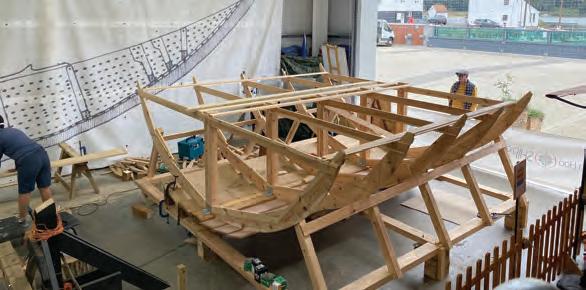
How you can help As work progresses and more definite plans are known the SHSC’s website will be updated and visitors will be able to watch via timelapse video. Visits to The Longshed will also be permitted, as Covid-related restrictions allow.
Public support remains vital to the project, of course, and money will be raised in a variety of ways, but the aim is for as many people as possible to be able to get involved and have their own part of this truly unique ship. Over time it will be possible to sponsor different parts of the ship, but initial fundraising efforts are concentrating on the fixings. In all, the ship needs 4308 different fixings which have been transcribed from archaeological records, and people can ‘Fund a Fixing’, or a collection of them, and in return for sponsorship will have their name on the roll of honour on the website. Sponsors will also receive a limited edition ‘Ships Company Sponsor’ pin badge and ownership card to have at home. As each fixing is added to the ship it will be recorded, so sponsors will be able to locate it in the final build. • www.saxonship.org

this model, allowing the viewer to step inside ‘the ship’ and gain some sensation of the scale and shape of what we are building,” explains Simon. “From these rivet maps, the team created the plans we are now using, allowing us to stay as close as possible to the archaeological record.”
Thanks to the SHSC’s own publicity efforts and, of course, The Dig, the project has captured the attention of people around the world, and attracted a number of famous followers. “We have seen views of our YouTube channel rise exponentially from a few thousand to over 70,000, and we used this as a catalyst to launch a Crowdfunder campaign to bring additional funds to our charitable project.” says Simon. “We have had significant support both financial and with our research, from Roger Michel and his team at the Oxford Institute for Digital Archaeology, which has had a tremendous effect. And finding out that the comedian Frank Skinner is a keen supporter and sponsor was a really nice surprise – who knew? Our appearance on Escape to the Country was also a welcome surprise – Jules Hudson, the presenter on the show, grew up locally to Woodbridge and is also a trained archaeologist and an avid supporter of our project. We’ve also had interest from further afield as Channel 9 Australia have just filmed a piece on our project, to be broadcast across Australia.”
At heart, though, this remains an experimental archaeology project; once the build is complete the ship will be launched and sea trials will commence. “Over a period of 12-24 months we aim to understand how the ship was rowed and steered, how many people it takes to propel the ship and at what speeds; the oar shapes, lengths and weights; the rudder/steering oar design and positioning; the number of crew required for longer trips or higher speed journeys – we anticipate needing in excess of a hundred trained rowing crew to allow shifts to take over on longer voyages,” says Simon.
“We need to understand what ballast requirement there is, whether there’s sufficient space to carry other goods, passengers, livestock, etc. Is it possible to easily beach and subsequently launch? We may even explore whether there was a sail, as this has been lost through the construction of the burial chamber for the king.
“Ultimately, if possible, we may also explore how the ship was hauled to the Sutton Hoo site for the burial. And as part of our experimental archaeology approach, all of this activity will be carefully and accurately recorded.” TheCoastalGuide 2021 45
Ready, steady… row!
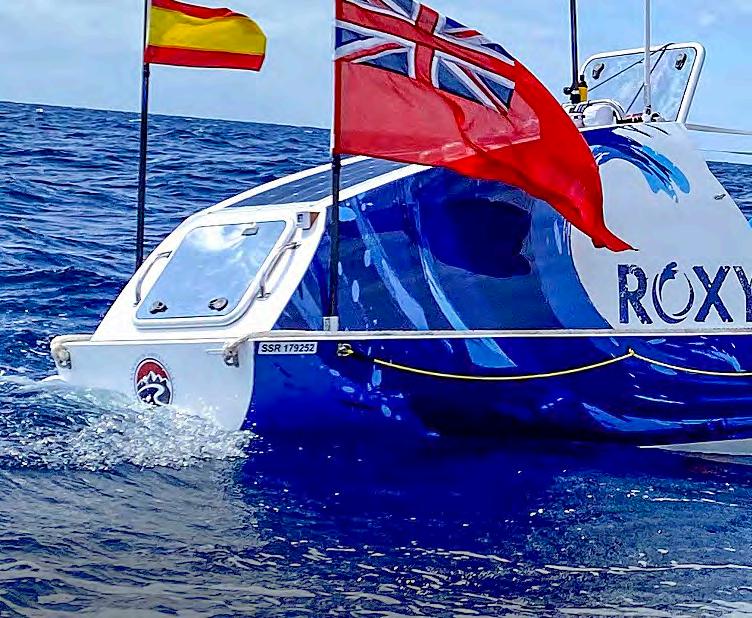
Ocean rowing may be an elite sport, but Essex is home to the world’s experts – and the starting point for an expeditions programme that encourages everyone to have a go
Burham Yacht Harbour is always a hive of activity, a-buzz with sailing and motor yachts, two RNLI lifeboats and the launches of the Essex Police Marine Unit. But in recent times it’s become RVP for a whole new class of watercraft too – one which relies on sheer grit rather than sails or an engine for making way across the water.
Local business Rannoch Adventure is largely behind the number of ocean rowing boats seen these days both on the River Crouch and further afield. Founded by Charlie Pitcher (pictured right), the company is based on the edge of town and is the go-to for anything to do with ocean and offshore rowing.
If you watched ITV’s gruelling Don’t Rock the Boat series last summer you’ll have seen Charlie – he was responsible for coaching the 12 celebrities before and during the month it took them to row the length of Britain, in boats made by Rannoch Adventure.
Charlie has sailed since he was five years old, and at 18 he was the youngest ever crew member to compete in the America’s Cup. But more recently his sea-going focus has shifted towards ocean rowing, and in 2009 he single-handedly beat all other solo and pairs boats to win the Woodvale Challenge Atlantic Rowing Race – a feat surpassed in 2013 when he broke the world record for the fastest unassisted solo row across the Atlantic by almost six days. Both crossings were completed, of course, in Rannoch designs.
Now Charlie and his team aim to make their sport more accessible to all, by launching a programme of Roxy Expeditions – named after the boat Rannoch RX80 – which anyone can apply to take part in.
After the last year of lockdowns, it’s fair to say that many of us are desperate to do something different, to get away from it all. But ocean rowing?
“People are searching for a new challenge, something unusual,” says Charlie. “Fewer people have rowed oceans than have climbed Everest – it is still very much a niche sport. But lockdown has
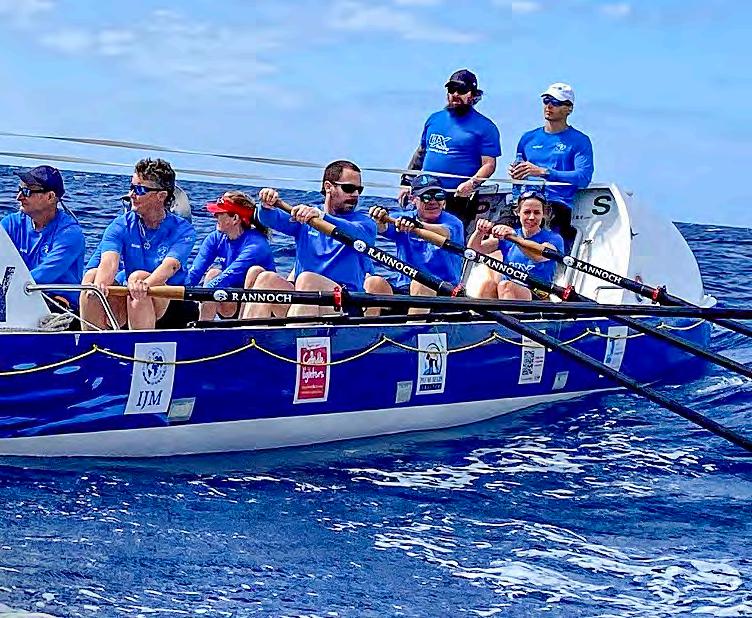
inspired many people to get in touch – they’ve had time on their hands to look for adventures and consider fulfilling their personal dreams.”
Rannoch Adventure already offers ‘taster’ sessions, so just how big a step is it to go from rowing on the River Crouch to crossing an ocean?
“Getting into rowing is easy. We really encourage anyone who’s keen just to get out on any boat and give it a go,” says Charlie. “Converting from river rowing to ocean rowing is just a matter of how adventurous you feel; it is different rowing 24/7 on an ocean for six or eight weeks at a time to rowing for two hours on a river.
“Ocean rowing is all about endurance and it’s actually more of a mental challenge than a physical one (although physical training helps hugely!). The rowing schedule for much of the time will be 12 hours of rowing per person per day, broken into two-hour shifts. It’s a tough schedule and is mentally and physically exhausting. Living in close quarters with others in a small vessel and unable to see land can also be emotionally challenging. This isolation is one reason why these expeditions are unique, but not necessarily suited to everyone.
“Rowing across an entire ocean under your own power is a fantastic achievement, and you will look back on the adventure with great pride. On the way, you will overcome many challenges, physically, mentally and socially. But the memories and friendships made along the way will hopefully last a lifetime.”
That’s a sentiment echoed by all who took part in the first Roxy Expedition, which crossed from Tenerife to Antigua – a 2,600 nautical mile adventure that took 42 days – this spring. » TheCoastalGuide 2021 47
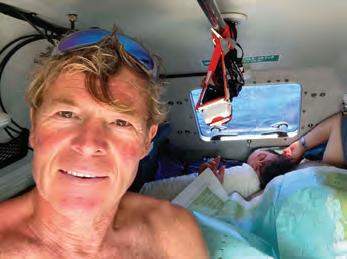
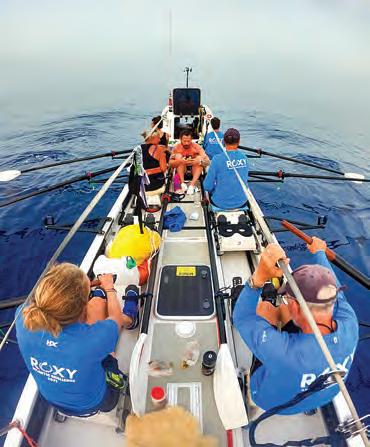
» With 12 on board and eight rowing positions, life over that time on the water was very much a case of row, eat, sleep and repeat. “Yes, we work a rotation of three hours on, hours hours off,” explains Charlie, “so generally we’d have six rowers rowing, six resting and eating. And if the weather is bad, we adjust the shift systems to have eight people rowing.”
With so many people living in such a confined space (as shown in the photos, right) communication, teamwork and consideration for others are key. But Charlie and his Rannoch Adventure colleagues take great care to put together the right people for each expedition. “It is very important to us that we choose team players whose reasons for undertaking these adventures are in sync with our ethos,” he says. “Roxy Expeditions are not about breaking records, they’re about enabling anyone to participate in this growing sport.
“Crossing an ocean on Roxy is cheaper than undertaking your own campaign, and you get the added safety net of having experienced Rannoch Adventure skippers on board.
“On this particular expedition, the youngest of the crew was just 19 and the oldest was 62. We had six males and six females and they all got to know each other throughout their training in 2020. During the pandemic, when getting together was more challenging, we had Zoom calls and lots of WhatsApp chat and banter. The team spirit and camaraderie was fantastic and I’m sure we will all remain friends for life.”
A blog on the Rannoch Adventure website made it easy for those on dry land to chart the progress of the Atlantic crossing, while it’s clear from the crew’s posts that it was a life-changing event – seasickness, frequent soakings, blistered skin, sore buttocks and a bucket for a toilet notwithstanding!
Weather information was passed to the skippers on Roxy via satellite communication systems. “Two phones on board enabled crews to call home when necessary,” says Charlie. “However, much of the ocean experience is about cutting yourself off from the world, not being in touch with it!”
Applications are now coming in for future Roxy Adventures, with the boat headed for destinations both far-flung and closer to home.
“Our round-Britain row this summer has been incredibly popular with people who are thinking of rowing an ocean but want a real taste of what life on board is like before they commit,” says
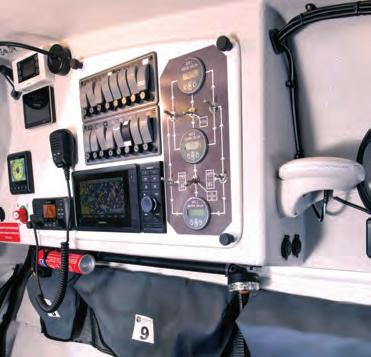
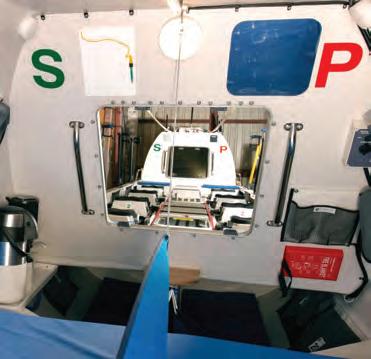
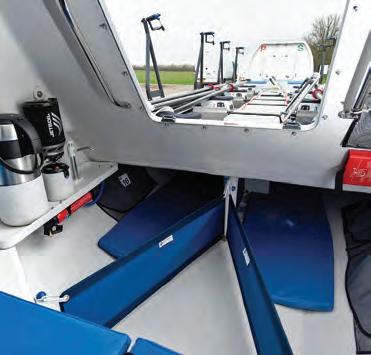
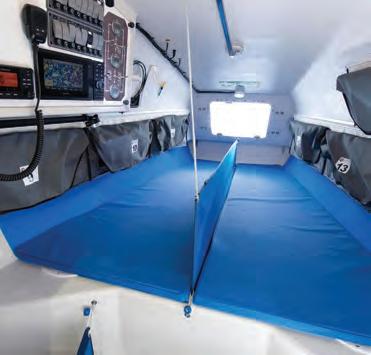
Charlie. “Each leg is just six days and you’re rarely out of sight of land. It’s a great way to try out ocean rowing and combine that with seeing the British coastline, which is one of the things I am really passionate about.
“We’re doing another Atlantic crossing in late 2021, and then the Indian Ocean in 2022 which really excites me personally – we’re taking applications for both these now. And a North West Passage is earmarked for the future.”
If you think you’re up for the challenge, the first step is to apply via email. “Tell us what sort of adventures you’ve already undertaken and why you want to row an ocean,” says Charlie. “We hold 30-minute Zoom calls with everyone, and then select our team.” Crew members can use the expedition as a way to raise funds for charity, and their place on the boat can be funded privately or by corporate sponsorship. • www.rannochadventure.com Dawn Wood, who rowed solo across the Atlantic in 2019, was enlisted by Charlie to co-lead this year’s first Roxy Adventure. Blogging from the boat as it neared the final week of rowing she said: “The sense of accomplishment doing something on your own is incredible, but I have also now seen the value of teamwork and being able to ask others for help and advice. Everyone on board has an amazing skill set to bring to the table so there hasn’t been a problem either boat- or personal-related that can’t be solved. “Friendship is another bonus of a crew expedition – we started the journey as strangers but we are nearing the end of this adventure as life long friends. Sharing experiences has got to be one of the biggest bonuses. I saw some incredible wildlife during my solo row, but only have photos to share; this time I have others to reminisce and smile with when we think of the day a huge pod of whales came to visit us. “This is a life-changing experience and every second of it should be enjoyed. Every person at some point on the row may have thought they could not carry on. But carry on they did.”

Elsewhere in the Atlantic blog, Roxy Adventurer Ian Kentfield wrote: “Line up three chairs by your dining room table, and now climb under your table. This space, roughly 1.5m height, 2.5m long, 1.5m wide is now home for the next 30-40 days. “This is your kitchen, sleeping, eating, resting, storage for personal possessions, dry clothing and wet clothing. Oh, and did I mention there are three of you here at a time! At the moment I have one applying Sudocrem to various parts of his anatomy whilst I make up breakfast and another tries to sleep. “After three hours, you can get up and sit in the chairs for another three hours, rocking backwards and forwards as though rowing. If someone can throw a bucket of water over you and try to push you over it’ll be so much more realistic. Three hours later, wet and exhausted, crawl back under the table, try to eat, and then sleep, before doing it all again. “Row, eat, sleep, repeat. It is relentless. It is exhausting. And yet, as I prepare to go on shift at dawn on day 30, I realise that I’m looking forward to it.”
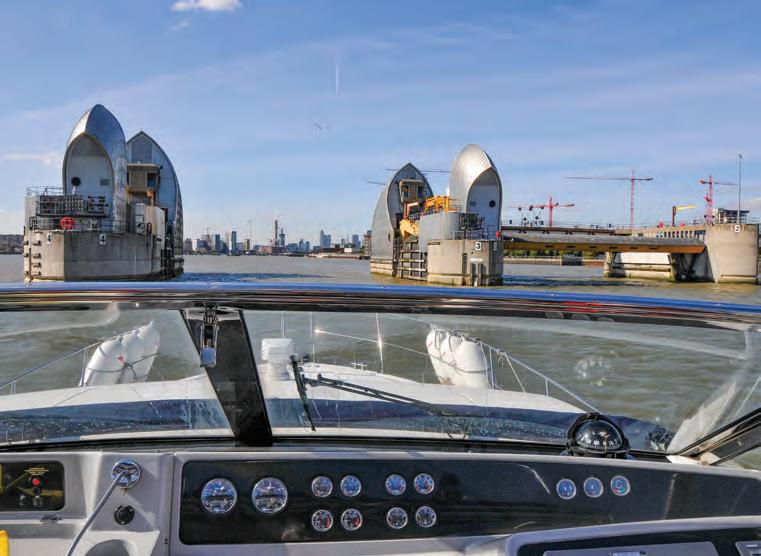
Navigating history
The Thames has played a strategic role in the nation’s past and today remains busier than ever, popular with commercial, commuter and leisure users
The Port of London handled the most cargo of any UK port in 2020 – 47.4 million tonnes – making it a vital supply line that kept the country fed, fuelled and supplied throughout the pandemic.
Terminals on the River Thames routinely handle a diverse range of cargoes including food, fuel, building materials and UK goods for export. But Port of London Authority chief executive Robin Mortimer, says: “Last year saw a massive collective effort across the port. Working together we kept essential supply chains running, so medicines, food and fuel arrived without delay.”
The Thames is the busiest inland waterway in the UK, of course, and also passing through the Port of London are numerous commercial and leisure craft. For sailing and motor yacht owners, cruising on the tidal Thames can be an exhilarating experience. In fact, many only consider they’ve truly ‘arrived’ once they’ve moored up in the upmarket surrounds of St Katharine Docks (left) – as central London’s only marina, it’s a great base for a few days in the capital.
A successful trip upriver from the estuary to Tower Bridge, however, relies on more than bravado and a big bank balance. Navigating safely and considerately around the large cargo
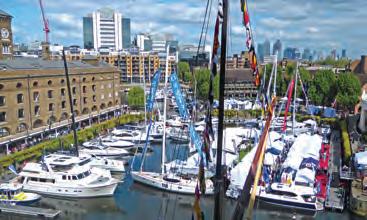
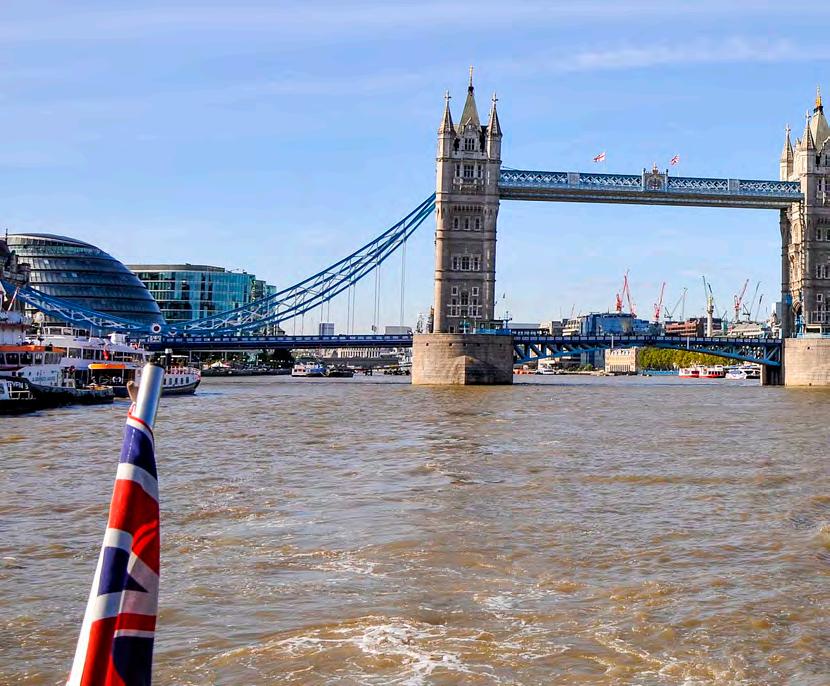
vessels that ply their trade to and from the Port of London is a priority. Then, once you’re through the Thames Barrier, the river becomes even more busy, with tugs and tows, fast commuter ferries and day-tripping boats all sharing the same relatively narrow channel. At times the wash on the Thames can get heavy too. The steep river walls reflect, rather than dissipate, the wash so it can be particularly rough at high water during busy traffic periods: 1.2m and 1.5m wave heights
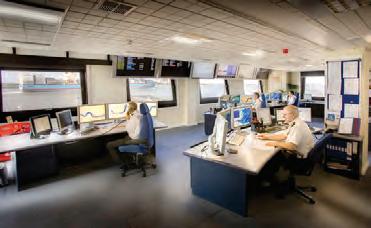
© Port of London Authority are not uncommon, so vessels and their crews must be suitable for the conditions.
The Port of London Authority suggests that Thames leisure users – and first-timers in particular – plan their passage for the quieter traffic times, which tend to be either before 11am or after 6pm during the summer months.
As the tidal Thames is linked to the sea, all sailing and motor vessels need to follow the International Regulations for Preventing Collisions at Sea, or ‘Col Regs’. But be aware that local byelaws exist which, in some circumstances, afford priority to motor vessels, contrary to what would be normal practice at sea.
The Port of London’s website for leisure users, Boating on the Thames, offers a wealth of advice for safe navigation. Key points to remember are: • Vessels must keep as near to the starboard side of the fairway at all times, as is safe and practicable, or follow the recommended routes shown on the PLA’s Recreational Users’ Guide. • You cannot cross from one bank to another
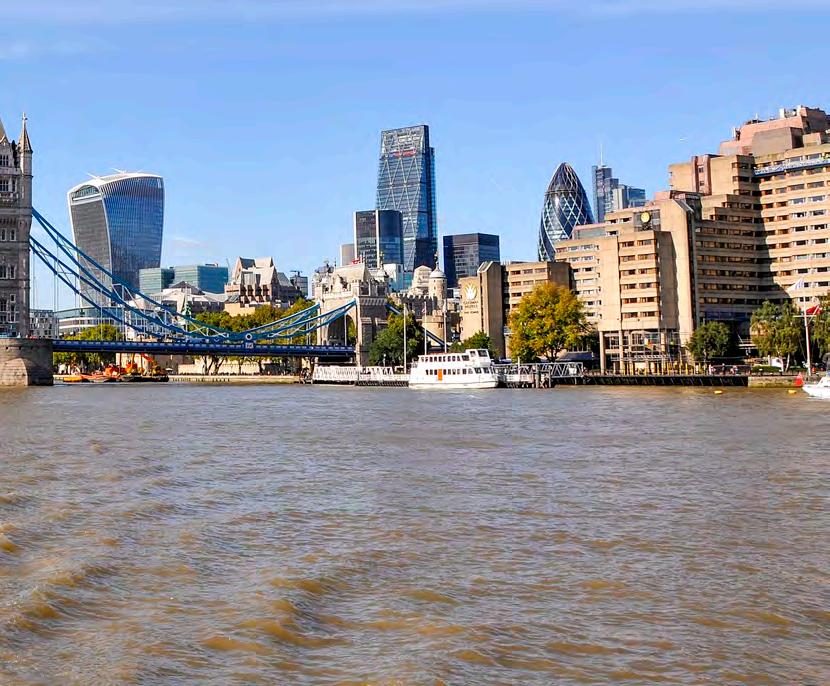
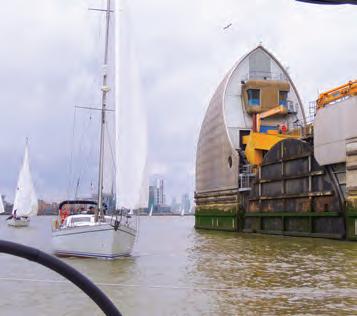

to tack along the river. If you are crossing the river, it is to get to a set location for a particular purpose (eg to leave or get to a mooring) and you must not tack, cross or enter the fairway so as to obstruct another vessel proceeding along it. • You must maintain a good look-out at all times – behind as well as in front. • If you find yourself approaching another vessel head-on, you should sound one short blast and keep to starboard. • When entering the river from a lock, pier or berth do not cross in front of another vessel. • At bridges, use the most starboard arch available to you provided it does not compromise your safety.
London VTS (Vessel Traffic Service) controls vessel movements on the Thames, and leisure skippers are advised to call in with details of the name of their boat, where and when they are entering the tidal Thames, their destination and the number of people on board. VTS will pass on any pertinent navigational information, such as river or bridge arch closures, and will also route traffic through the iconic span of the Thames Barrier – contact London VTS on VHF Channel 14 at either Margaretness inward-bound, or Blackwall Point outward-bound. » • www.boatingonthethames.co.uk

ENJOY ON THE WATER Time
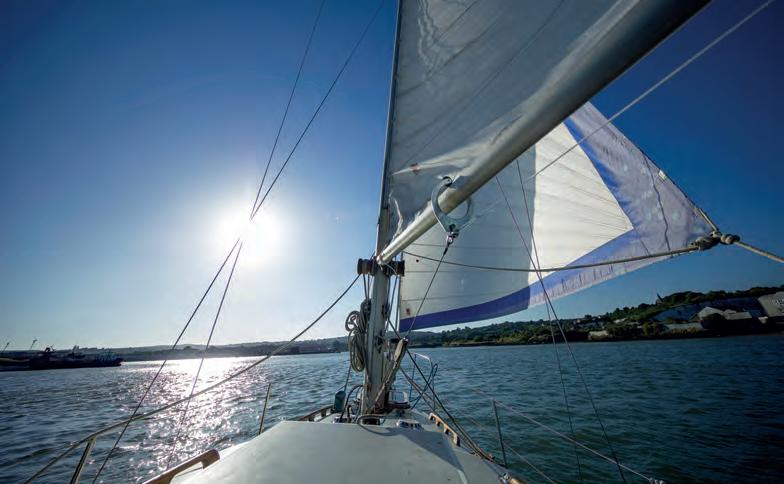
AT CHATHAM MARITIME MARINA
Nestled on the River Medway in Kent, Chatham Maritime Marina is a perfect base for exploring, with many secluded anchorages perfect for lazy lunch stops. You’re spoilt for choice on land too, with a multiscreen cinema, an outlet shopping complex and a variety of restaurants and bars nearby.
12-MONTH BERTHS FROM £393

PER METRE*
• Range of annual berthing and short-term packages • Accessible at all states of the tide through a lock entrance** • Next to the Historic Dockyard Chatham • Within easy reach of London and Bluewater shopping centre • Otium Reward points every time you buy MDL services - GET BACK up to 5% on your berthing fees - GET BACK up to 17% on fuel - GET BACK up to 20% on visitor berthing - GET BACK up to 22% on boatyard services
* Price for a 10m boat on the Berthing Plus Otium package ** Some restrictions may apply to vessels exceeding 1.5m draft

GET A QUOTE TODAY!
T: 01634 899200 E: chatham@mdlmarinas.co.uk W: chathammaritimemarina.co.uk
HMM Algeciras visited the Port of London in June 2020 on her maiden voyage. She was the first of a class of 12 container ships that have a capacity of 23,964 twenty-foot equivalent units (TEU) – the largest container ships in the world when they were launched.
© Port of London Authority

The Port of London has launched a free app which is it claims is the essential companion to the tidal Thames.
Available for iOS via the App Store and Android via Google Play, it offers info including: • Live tidal data from 12 locations along the 95-mile tidal river. • Alerts for Notices to Mariners, which detail the latest information on events, engineering works and recent changes that users need to be aware of before setting off. • An events calendar covering planned rowing, sailing and paddling activities. • Details of all the mooring locations along the river, including amenities at each location such as mains electric, fuel, and pump-out facilities.
The app can be customised for the location you most regularly need information on, so you can choose your default tide gauge, your preferred river district and whether or not you want to see the Ebb Tide flow indicator. © Port of London Authority The Port of London Authority was created to bring order to the chaos and congestion that prevailed on the Thames as rival wharfs, docks and river users battled for business in the late 1800s. Structural improvements were considered essential to maintain and improve the Port’s position against its leading European rivals and, after years of hot debate, the Bill that led to the creation of the PLA was introduced by David Lloyd George in April 1908, receiving Royal Assent as the Port of London Act, 1908, in December of that year.
In the years immediately after its formation, the PLA oversaw investment and modernisation of the docks, deepening of the river and brought co-ordination - and a new sense of identity - to a busy, successful Port which subsequently played its part in the nation’s efforts through two World Wars and the rebuilding that followed.
Today the PLA employs 360 people and continues in its core role, helping people make the most of the river safely whether for deep-sea trade, river- borne freight within London, commuting, sailing or rowing. Its operations cover 95 miles of river from Teddington Lock to the North Sea.
If you’re in London and interested in the history of the Thames and its trade, a visit to the Museum of London Docklands at West India Quay, Canary Wharf is highly recommended
The PLA archive is held here, and includes more than 600 unique record books of private dock companies from 1799, along with objects, documents, plans, photographs and film charting the development of the Port of London and the River Thames from the late 18th century, to redevelopment in the 20th century. • www.museumoflondon.org.uk/museum-london-docklands
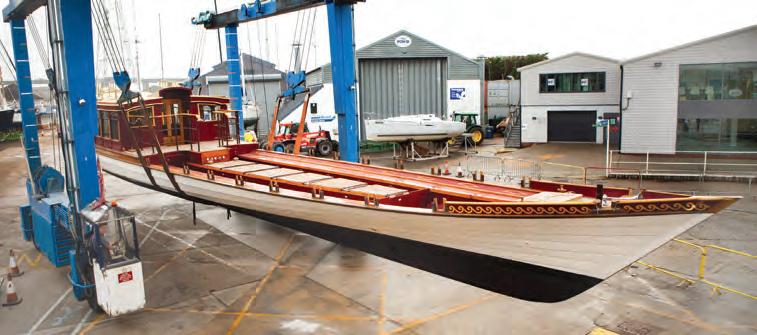

On Her Majesty’s service
The Royal rowbarge is restored to full glory thanks to the craftsmanship of a River Orwell boatyard
Boat owners on the East Coast are spoilt for choice when it comes to accessing expert help with the repair and restoration of their vessels, and many of the region’s boatyards have remained busy even through the past year of pandemic-related problems.
At Fox’s Marina & Boatyard in Suffolk there’s been a VIP visitor: Her Majesty The Queen’s Rowbarge, Gloriana. The prestigious vessel travelled by road from the River Thames to Fox’s on the River Orwell for a carefully-managed refit. The work involved complete re-finishing of topsides, bottom and all exterior surfaces including the specialist application of two-pack paints, varnishes and gold leaf.
Fox’s state-of-the-art heated workshops have the capacity for vessels up to 100ft long, so at 88ft Gloriana fitted comfortably in her secure, temporary home.
Built in 2012 to celebrate The Queen’s Diamond Jubilee, the 18-oared row barge has an all-wood structure including fully gilded ornate carvings and bright work.
Although Gloriana was the first Royal barge built in over 250 years, her design and build replicate structures and techniques that have changed little since the clinker-built long-boats of the Viking age.
Established in 1927, Fox’s Marina & Boatyard has more than 40 highly skilled on-site craftsmen. Together they offer specialised rigging, marine electronics, engineering, spray painting, and stainless fabrication services, as well as a wealth of experience in traditional boat building and classic yacht repairs.
The site is also home to the UK HQ of luxury yachtbuilder Oyster Yachts, and has in recent years added a £1.5m waterside office development which houses a new Harbour Master’s office, facilities for berth holders and the new Outlook Café, Bar & Bistro. • www.foxsmarina.com

